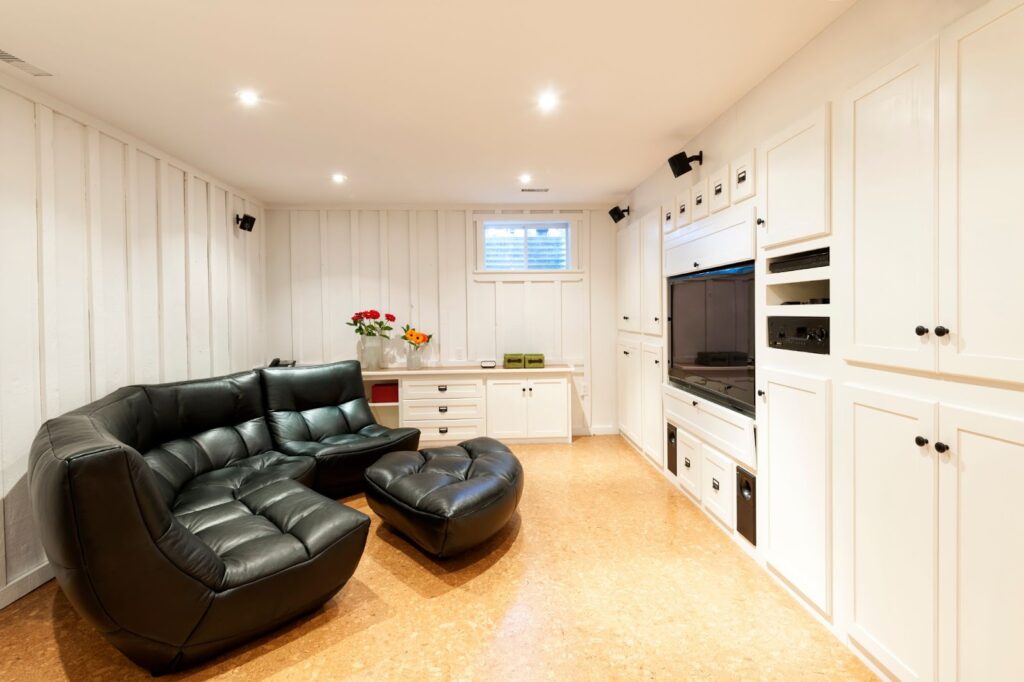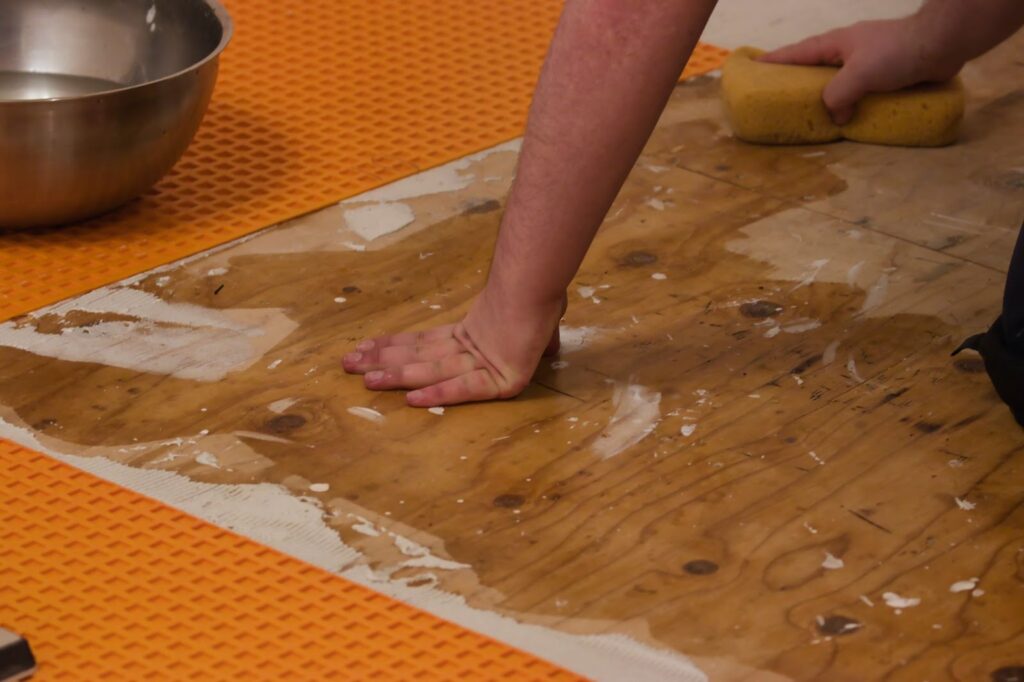Selecting basement flooring is a critical decision that goes beyond aesthetics. It requires carefully considering various factors that impact the functionality and longevity of your flooring choice.
Whether you’re transforming your basement into a cozy family room, a functional home office, or a robust gym, each scenario demands specific flooring attributes that can handle the unique environment of an underground space.
In this comprehensive guide, we’ll explore the key considerations that every homeowner should ponder when choosing basement flooring. From understanding moisture levels to evaluating wear and tear, these insights from expert basement contractors will ensure you make an informed decision that aligns with both your practical needs and stylistic preferences.
So, let’s dive into the essential strategies for selecting the perfect basement flooring to enhance your living space.
1. Assess your basement’s environment
First, note the moisture levels in your basement. Due to their location below ground level, basements are more prone to excess moisture and humidity. This might result in dampness, which is not ideal for certain types of flooring. Excess moisture often leads to mold and mildew growth, which may harm your health and damage your flooring over time.
To assess the moisture levels in your basement, start by performing a simple test. Tape a plastic sheet, about 2 feet by 2 feet, onto the floor in different areas of your basement.
Leave it for a day or two and then check for condensation or moisture accumulation on the underside of the plastic. If you notice water droplets or dampness, your basement likely has high moisture levels.
If your basement is prone to being damp, it’s essential to choose flooring that will withstand these conditions. Options such as vinyl, ceramic tiles, or concrete are suitable for areas with high moisture.
Vinyl flooring is especially popular for basements due to its water-resistant and durable properties. It provides a protective barrier against moisture and prevents it from seeping into your flooring.
Another important factor to consider when assessing your basement’s environment is the temperature. Basements tend to be cooler than the rest of your home, and this can affect certain types of flooring. Some flooring materials, like hardwood or laminate, are sensitive to temperature fluctuations and will expand or contract in response, leading to cracks or gaps in the flooring.
To combat this issue, you can opt for flooring materials that are more temperature-resistant, such as porcelain tiles or vinyl. These materials are better able to withstand the cooler temperatures in your basement and maintain their stability and appearance over time.
Additionally, consider the potential for water leaks or flooding in your basement. While it’s crucial to address the root cause of any water issues, it’s also wise to choose flooring that is able to handle occasional water exposure.
Carpet is generally not recommended for basements prone to flooding or leaks, as it is challenging to dry and can harbor mold. Instead, consider options like engineered wood or interlocking tiles that you can easily remove and dry if water damage occurs.

2. Determine usage and functionality
Determining the usage and functionality of your basement is a crucial step when selecting the right flooring. The basement serves various purposes, depending on each homeowner’s needs and preferences.
If you plan to use your basement primarily as a storage area, durability should be your top priority. You want a flooring material that can withstand heavy items being dragged or dropped without causing any damage.
Epoxy coatings, concrete, or luxury vinyl tiles (LVT) are great choices for this purpose. Epoxy coatings create a seamless, durable, and easy-to-clean surface that is resistant to stains and spills.
Concrete is also a practical and low-cost option, especially if you plan to use rugs or other floor coverings to enhance the space’s comfort.
LVT, on the other hand, is water-resistant, making it ideal if your basement has potential leaks or moisture issues.
If you intend to transform your basement into a home gym or a playroom, shock absorption and comfort become significant factors. You want a flooring material that will provide a cushioned surface to protect against injuries and offer a comfortable feel underfoot.
Rubber flooring or carpet tiles are excellent options for these purposes. Rubber flooring provides shock absorption, is slip-resistant, and can handle heavy equipment without causing damage. Carpet tiles offer versatility, as you can easily replace them if they get damaged, and they provide warmth and comfort for kids to play on.
Aesthetics and comfort are the primary concerns for those looking to create a space for entertainment or relaxation. Carpet or luxury vinyl planks (LVP) will help create a cozy and inviting atmosphere. Carpet provides warmth and sound insulation, making it a popular choice for family rooms or home theaters in the basement.
LVP offers a wide range of designs, including wood and stone patterns, allowing you to achieve a stunning and elegant look. Additionally, LVP is easy to clean and maintain, making it suitable for areas where food and drinks may be consumed.
3. Explore waterproof and water-resistant options
When it comes to selecting the right flooring for your basement, one of the most important factors to consider is its ability to resist water.
Luckily, there are plenty of innovative and practical options available in the market today that offer excellent water resistance. These options provide a durable and attractive flooring solution and offer peace of mind knowing that your basement will remain dry and free from any potential water-related issues.
One popular choice for basement flooring is ceramic or porcelain tile. These tiles are made from materials that are naturally water-resistant, making them ideal for basements. Ceramic and porcelain tiles are resilient to water, highly durable, stain-resistant, and easy to clean.
Additionally, they come in a wide variety of colors, styles, and patterns, allowing you to select one that best suits your personal taste and complements the overall aesthetics of your basement.
For a more natural and eco-friendly option, consider engineered hardwood flooring. Unlike traditional hardwood, engineered hardwood is constructed from multiple layers of wood with a top layer of hardwood veneer. This construction makes it more resistant to moisture and fluctuations in humidity, making it suitable for basement environments.
Engineered hardwood offers the classic and timeless beauty of genuine wood while providing better water resistance and durability compared to solid hardwood flooring. However, while engineered hardwood is water-resistant, it is not completely waterproof, so it is essential to promptly clean up any spills or moisture to prevent any potential damage.
If you’re looking for a budget-friendly and easy-to-install option, consider laminate flooring. Laminate flooring consists of synthetic layers that are fused together and topped with a protective layer.
This construction makes it highly resistant to moisture and spills, making it an excellent choice for basement areas. Laminate flooring is also known for its durability and low maintenance requirements.
It is available in various styles and designs, including options that mimic the appearance of hardwood or stone. With laminate flooring, you’ll achieve the desired look for your basement without breaking the bank.

4. Look into sub-flooring requirements
When it comes to selecting the right basement flooring, there are many factors to consider.
One important consideration is the subflooring requirements. As the name suggests, the subflooring is the layer underneath the actual basement flooring. It is crucial to have a proper subflooring system in place to ensure the longevity and durability of your basement flooring.
Why is subflooring important? The sub-flooring acts as a barrier between the basement floor and the concrete slab, preventing moisture from seeping into the flooring material.
Before selecting a basement flooring material, it is essential to evaluate the condition of your subflooring. If you have an existing concrete slab, it’s a good idea to have a basement contractor inspect it. They can identify any cracks, unevenness, or moisture-related issues that need to be addressed before installing the new flooring.
Once you have determined the condition of your sub-flooring, you can then consider the various types of basement flooring materials available.
When selecting a basement flooring material, it is crucial to choose one that is compatible with your subflooring. Some flooring materials require an additional moisture barrier or insulation layer, while others can be directly installed on top of the subflooring.
To ensure proper installation, consult with a flooring professional or follow the manufacturer’s guidelines.
Finish your basement flooring with Utah Basement Builders
Ready to upgrade your basement with flooring that perfectly suits your lifestyle and needs? Utah Basement Builders are here to help. As experienced basement contractors, we specialize in transforming basements into beautiful and functional spaces.
Our team is dedicated to providing personalized solutions, ensuring that your new basement flooring looks great and withstands the challenges of basement environments.
Don’t navigate the complexities of flooring selection alone; trust the experts at Utah Basement Builders. Contact us today to discuss your basement renovation project and discover how we can help you achieve the basement of your dreams!
situs hk toto slot toto slot slot thailand situs slot gacor toto togel toto slot slot online situs toto situs togel bento4d login toto slot situs gacor